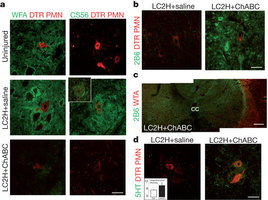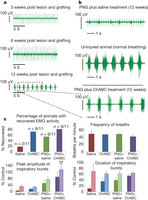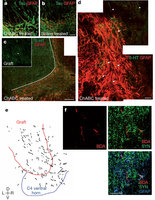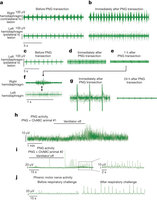摘要:神经科学家7月13日报告说,他们通过让颈部神经被切断的实验室小鼠恢复呼吸,从而在对抗脊髓受损方面取得了进展。
科学家们说,这项技术尚需在人体进行测试,但是如果证明它有效,那么脊髓受到灾难性损伤的患者所遭受的一个大问题或将得以缓解。
第四颈椎以上受损的人都会出现呼吸受阻的情况。患者不得不使用呼吸器,而这会带来呼吸道感染的反复发作。
在通常情况下,呼吸的频率和力道是由脑干中的神经细胞自动控制的。为了实现呼吸,这些神经细胞轮流控制着分布于第三到第六颈椎的运动原细胞。这些运动原细胞进一步向下形成所谓膈神经。膈神经促使膈肌放松或收缩,并促使肺部气体充满或排空。
杰里·西尔弗是凯斯—西部保留地大学医学院的教授。他领导的团队报告了如何在重要的颈部区域搭桥的试验性方法。
他们破坏了小鼠第二颈椎处的脊髓以造成二分之一的隔膜不能正常活动,然后将小鼠四肢上一小段外周神经移植过来,将它连接在受损部位的前后。
这种方式是利用外周神经形成一座桥梁,使得膈神经的前体细胞可以在上面生长。
3个月后的测试显示,80%-100%的小鼠呼吸功能得以恢复。
西尔弗在新闻发布会上说:“我们首次证明,远距离再生方法可以全面恢复呼吸系统的功能。”他警告说,在把这项技术用于人类试验之前还需要在实验室进行更多研究。这项研究发表在英国《自然》杂志上。
西尔弗又说,他的实验室已经开始就恢复膀胱功能进行准备工作。恢复膀胱功能是脊髓较低部位受损的病人最需要得到的帮助。
生物探索推荐英文论文摘要:
Functional regeneration of respiratory pathways after spinal cord injury
Abstract:
Spinal cord injuries often occur at the cervical level above the phrenic motor pools, which innervate the diaphragm. The effects of impaired breathing are a leading cause of death from spinal cord injuries, underscoring the importance of developing strategies to restore respiratory activity. Here we show that, after cervical spinal cord injury, the expression of chondroitin sulphate proteoglycans (CSPGs) associated with the perineuronal net (PNN) is upregulated around the phrenic motor neurons. Digestion of these potently inhibitory extracellular matrix molecules with chondroitinase ABC (denoted ChABC) could, by itself, promote the plasticity of tracts that were spared and restore limited activity to the paralysed diaphragm. However, when combined with a peripheral nerve autograft, ChABC treatment resulted in lengthy regeneration of serotonin-containing axons and other bulbospinal fibres and remarkable recovery of diaphragmatic function. After recovery and initial transection of the graft bridge, there was an unusual, overall increase in tonic electromyographic activity of the diaphragm, suggesting that considerable remodelling of the spinal cord circuitry occurs after regeneration. This increase was followed by complete elimination of the restored activity, proving that regeneration is crucial for the return of function. Overall, these experiments present a way to markedly restore the function of a single muscle after debilitating trauma to the central nervous system, through both promoting the plasticity of spared tracts and regenerating essential pathways.

Figure 1: C2 hemisection results in CSPG production.

Figure 2: A PNG enhances diaphragmatic EMG activity.

Figure 3: ChABC treatment promotes axon regeneration.

Figure 4: PNG transection initially increases tonic diaphragmatic EMG activity then completely eliminates activity.







